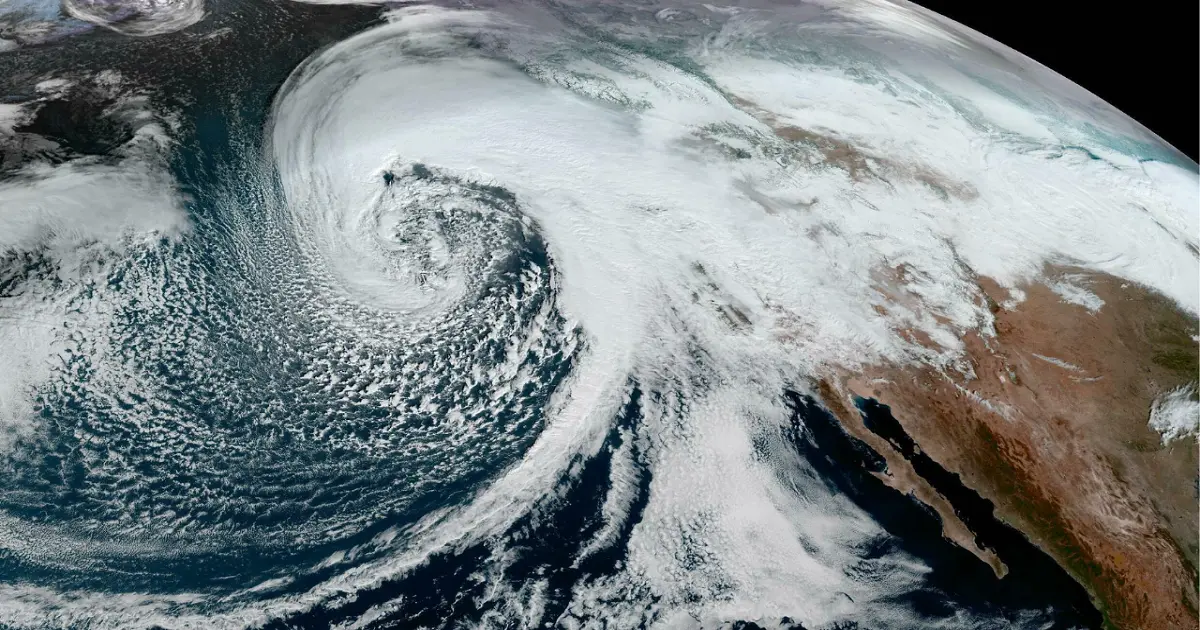In recent years, California experienced an extraordinary and forceful weather event known as the “Bomb Cyclone.” This rare meteorological phenomenon is characterized by a swift and dramatic drop in atmospheric pressure, resulting in severe weather conditions. This article delves into the causes, impacts, and coping strategies related to the Bomb Cyclone in California.
What is a Bomb Cyclone?
A Bomb Cyclone, scientifically called “bombogenesis,” occurs when a midlatitude cyclone rapidly intensifies, decreasing at least 24 millibars in its central pressure within 24 hours. This rapid pressure drop strengthens the cyclone’s winds, bringing the potential for severe weather events such as heavy rain, strong winds, and even blizzards.
Causes and Conditions
The formation of a Bomb Cyclone typically requires a specific combination of weather conditions. An essential factor is the presence of a significant temperature contrast between cold arctic air and warmer ocean or land temperatures. The collision of these air masses creates a low-pressure area at the surface, intensifying the cyclone.
In California, Bomb Cyclones are often associated with powerful winter storms originating in the Pacific Ocean, also known as “Pineapple Express” storms. These storms bring warm, moisture-laden air from the Hawaiian region to California, where it collides with colder air masses, creating ideal conditions for bombogenesis.
Impacts on California
The impacts of a Bomb Cyclone in California can be extensive and diverse, varying with each specific event. Potential impacts include:
Heavy Rainfall: Bomb Cyclones can bring intense rainfall, leading to flash floods, landslides, and disruptions to transportation and infrastructure.
High Winds: The rapid intensification of the cyclone can cause powerful winds, resulting in fallen trees, power outages, and damage to buildings and structures.
Snow and Blizzard Conditions: In certain regions, mainly mountainous areas, the rapid pressure drop can lead to heavy snowfall and blizzard-like conditions, posing risks to travelers and residents.
Coastal Flooding: The combination of strong winds and high tides can result in coastal flooding and erosion, affecting coastal communities and ecosystems.
Preparing for a Bomb Cyclone
Since Bomb Cyclones are rare yet powerful weather phenomena, Californians must be prepared when such conditions are forecasted. Key preparedness measures include:
Stay Informed: Monitor weather forecasts and official advisories from local authorities to stay informed about the approaching storm and its potential impacts.
Emergency Kit: Have an emergency kit ready, including essential supplies such as food, water, flashlights, batteries, and first-aid items.
Secure Outdoor Items: Before the storm, secure or store outdoor items such as furniture, equipment, and decorations to prevent damage from strong winds
Evacuation Plan: If you live in a flood-prone or high-risk area, have a clear evacuation plan and be prepared to evacuate if necessary.
Stay Indoors: During the storm, stay indoors and away from windows to protect yourself from high winds and flying debris.
The Pineapple Express and Bomb Cyclone Duo
The combination of the Pineapple Express storm and a Bomb Cyclone can create a potent and dynamic weather duo in California. The Pineapple Express, known for its atmospheric river of moisture from the tropical Pacific, collides with a developing low-pressure system, triggering the rapid intensification characteristic of a Bomb Cyclone.
The Pineapple Express: A Tropical Connection
The Pineapple Express is a weather phenomenon from the tropical Pacific Ocean, often near Hawaii. This atmospheric river carries a plume of moisture-laden air across the ocean toward the western coast of North America. When this plume encounters the colder air masses along the California coast, it can produce intense and prolonged rainfall, resulting in heavy precipitation and the potential for flooding.
The Bomb Cyclone: A Rapid Intensification
When the moisture-laden air from the Pineapple Express interacts with a developing low-pressure system, it triggers a dramatic drop in atmospheric pressure, leading to bombogenesis. During bombogenesis, the storm’s central pressure decreases rapidly, intensifying the cyclone’s winds and strengthening its core.
The Impact of the Duo
The duo of the Pineapple Express and the Bomb Cyclone can have far-reaching impacts on California. The intense rainfall from the Pineapple Express can cause flash floods and landslides, especially in areas with steep terrain and vulnerable soil conditions. Coastal regions may experience storm surges and high tides, leading to coastal flooding and erosion.
The powerful winds associated with the Bomb Cyclone can bring down trees and power lines, leading to widespread power outages. In mountainous areas, the rapid pressure drop can cause heavy snowfall and blizzard conditions, posing risks to travelers and residents.
Preparedness and Mitigation
Given the potential for significant impacts from this weather duo, preparedness, and mitigation are crucial. Local authorities and weather forecasting agencies closely monitor developing weather patterns to issue warnings and advisories in advance. Residents in at-risk areas should stay informed through official sources and be ready to take necessary precautions.
Measures such as securing outdoor items, having emergency kits on hand, and having a clear evacuation plan for flood-prone areas can help residents stay safe during these intense weather events. Additionally, building and infrastructure codes in vulnerable regions should incorporate resilient designs to withstand the potential impacts of the Pineapple Express and Bomb Cyclone duo.
Climate Change and Future Implications
As the climate changes, ongoing research delves into its potential impact on weather patterns, including the frequency and intensity of atmospheric river events and cyclones. Understanding these connections is vital for building climate resilience and preparing for the changing dynamics of severe weather events in California and beyond.
Frequently Asked Questions (FAQs)
How often do Bomb Cyclones occur in California?
Bomb Cyclones are relatively rare events in California. They are more commonly associated with regions further north, such as the East Coast of the United States.
Can a Bomb Cyclone cause tornadoes in California?
While Bomb Cyclones can bring severe weather conditions, including strong winds, tornadoes are uncommon in California. Tornadoes are more prevalent in areas with different weather patterns.
How is a Bomb Cyclone different from a regular cyclone or hurricane?
A Bomb Cyclone is a specific cyclone that undergoes rapid intensification within a short period. Regular storms and hurricanes can also be powerful, but they may not experience the same rapid drop in pressure as Bomb Cyclones do.
What are some of the worst impacts of a Bomb Cyclone in California?
The worst impacts of a Bomb Cyclone in California can include extensive flooding, landslides, widespread power outages, and damage to infrastructure and properties due to high winds.
Are there any early warning systems for Bomb Cyclones in California?
Weather forecasting agencies monitor conditions that can lead to the formation of Bomb Cyclones and issue warnings and advisories accordingly. Staying informed through local weather forecasts and official announcements is crucial for preparedness.
Conclusion
A Bomb Cyclone is an uncommon and potent weather phenomenon that can significantly impact California. Understanding the causes and being prepared for such events is crucial to ensuring the safety and well-being of residents. By staying informed, taking necessary precautions, and cooperating with local authorities, Californians can mitigate the risks and challenges posed by a Bomb Cyclone, effectively weathering the storm.






